Replica of Swede Savage’s Gurney Eagle honors an Indy driver’s life cut too short

“It’s spectacular,” said Mike Lashmett, and it is. But oh, so tragic.
The car is the spitting image of the red STP-sponsored number 40 original that broke the track record in qualifying for the 1973 Indianapolis 500, the one that led the race for 12 laps before Californian driver Swede Savage died as a result of one of the most horrific crashes ever seen at the Indianapolis Motor Speedway.
The product of a well-regarded shop—Duman’s Turn 4 Restorations in Brownsburg, Indiana—the new number 40 replica is co-owned by writer Ted Woerner and Lashmett, the head of the seven-year-old Vintage Indy Registry. The registry represents more than 200 privately restored Indy Cars.
“We do track companion races, mostly with IndyCar, averaging between 25 and 30 cars per event. For instance, we’re going to St. Louis with IndyCar for the sixth straight year next weekend. I have 25 cars going down there from a 1930 Miller through a 2002 G-Force,” Lashmett said.
Plus Swede Savage’s lookalike car, which is making its debut. It’ll take the track at World Wide Raceway outside of St. Louis in on Saturday, August 26, which would have been Swede Savage’s 77th birthday. This year is the 50th anniversary of his crash.
The car they acquired, like the car Savage crashed, was built originally by the legendary racer Dan Gurney—the All American Racers (AAR) chassis 72-29. “A little over two years ago we purchased it,” Lashmett said. “We made the decision to transform this car—take it down to bare-bones—fit it with all old-new AAR-stock body parts paint it, and decal it as a tribute to Swede Savage.
“That’s what we did. And it’s probably one of the most period-correct Gurney Eagles out there.”
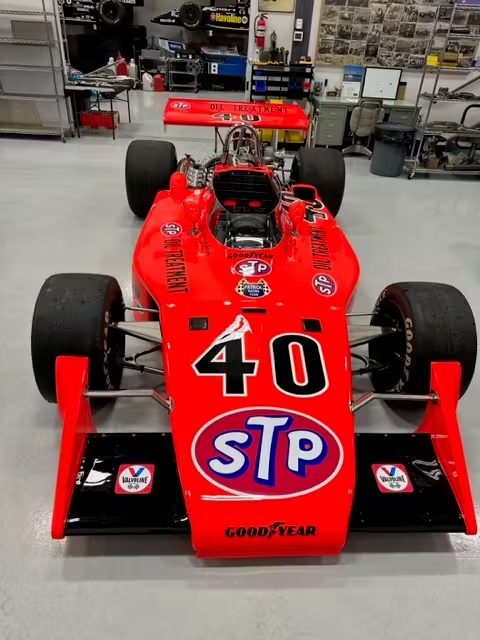
Woerner, a Savage fan since the age of 11, literally wrote the book on Savage (Savage Angel: Death and Rebirth at the Indianapolis 500, available at Autobooks-Aerobooks.com).
“I was 11, and a huge IndyCar fan. Swede was always at the top of the charts; he seemed like a pretty cool guy and I became a fan.” He went to Pole Day qualifying, “and I saw him break the track record in that beautiful number 40 STP car. I couldn’t wait to see how he did in the race. And we all knew what happened then.”
So, what did happen?
Multiple tragedies strike Indy
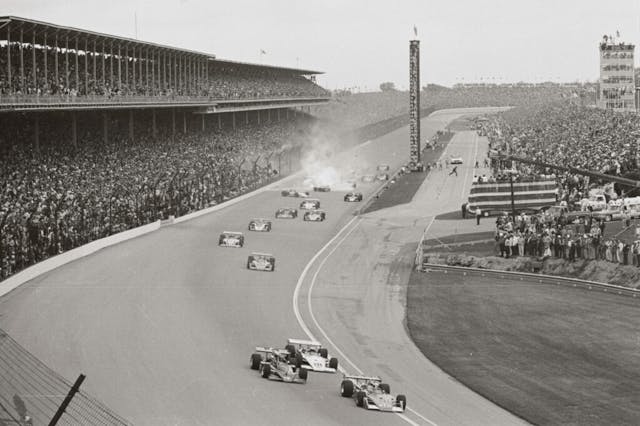
The 1973 Indianapolis 500 was one of the darkest in the race’s history. During a practice session on May 12, well-liked driver Art Pollard was killed in a practice crash. The race was scheduled for May 28, but a there was a crash at the start when driver Salt Walther’s car launched into the catchfence, dousing dozens of fans with burning fuel. During the resulting red flag period, rain began falling, washing out the race. It rained all the next day, too.

Rain was still in the forecast when the race resumed on Wednesday, May 30, with a comparative handful of fans in the grandstands. The previous crashes, the weather, and the fact that the cars were hovering just shy of the 200 mph mark made for a profoundly tense day. The infield was full of mud and garbage. Drivers and crews and track personnel were exhausted, apprehensive.
None of this seemed to matter to Savage. He knew he had a genuine shot at winning the world’s biggest race, and it appeared he might, despite competition from drivers like Mario Andretti, A.J. Foyt, Mark Donohue, Peter Revson, Bobby Allison, Al and Bobby Unser, and Mel Kenyon.

The track dried out and the race started late, at 2:10 p.m. Savage led for part of the race’s early going, before pitting on lap 57 for fuel. He re-entered the course with a full fill of methanol aboard, plus a new right rear tire.
Savage was gaining on race leader Al Unser and about to take the lead once Unser made his pit stop.
Then, on lap 59, coming out of Turn Four onto the main straight, Savage’s car darted to the left and made almost a 90-degree turn into the inside wall. The car exploded. Flames shot 60 feet into the air.
Savage was still strapped into his seat, attached to part of the car’s center section, which had slid to the outside wall and come to rest upright. The 26-year-old was sitting in a pool of flaming methanol. Somehow, with multiple broken bones and badly broken legs, he was moving, trying to free himself and talking to the safety crew as even more fire trucks and ambulances rushed to his aid.
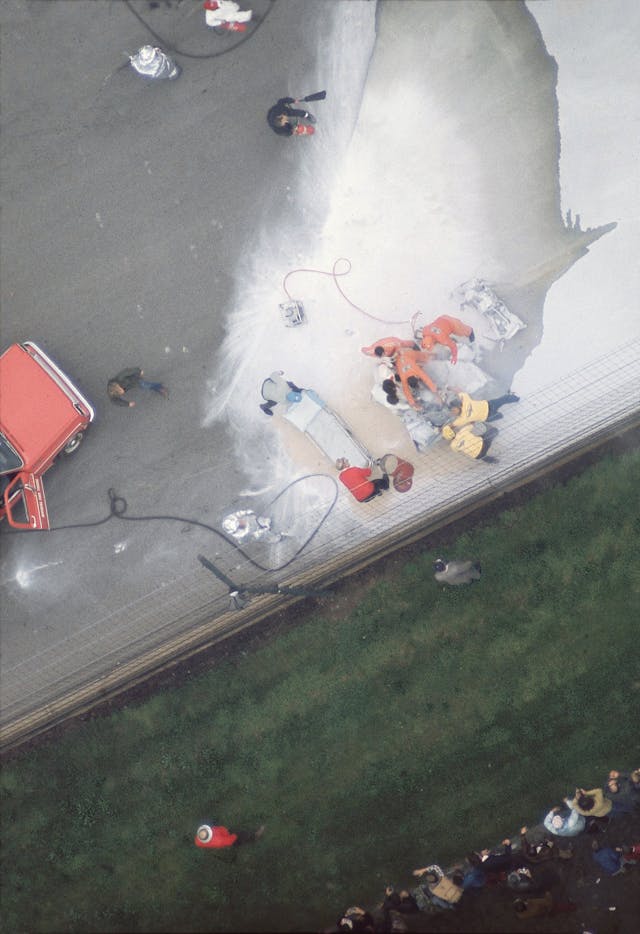
A 23-year-old crew member, Armando Teran, ran into the fray to help. A fire truck, traveling 60 mph the wrong way up pit road, struck Teran and threw him high in the air. He was killed.
Savage, stunningly, survived the crash. In the hospital, he was given tainted plasma and developed hepatitis B. But it was the damage to Savage’s lungs that most probably caused his death, 33 days after the crash, with his pregnant wife, Sheryl, by his side.
Gordon Johncock won the race (Lashmett was a crewman on the car) which was rain-shortened yet again. The celebration was soggy, grim, and muted. Savage, who led 12 laps, was credited with finishing 22nd. Of the 33 starters, only 11 cars were running at the end.
You can watch the crash on YouTube, but be sure you really want to see it before you click on the link.
What caused the crash? Woerner, the writer, thinks he knows.
“Swede pitted the lap before and took on a full load of fuel, back then it was 75 gallons, 500 pounds of fuel in a car that’s already lightweight. Even under the best of circumstances the handling characteristics are going to be dramatically different.
“To compound that, they only changed his right rear tire. Three warm tires and one cold tire, and the cold tire is the right rear, which is under the most stress in the corner, so by the time he hit the north end of the track he was up to racing speed and I just think it got away from him coming out of Turn Four.”
At best, Gurney’s Eagle Offenhauser race car “was a handful,” Woerner said. Besides Savage and Art Pollard, Jim Malloy was killed in one such car at the 1972 Indy 500, the year prior, and stock car champ Lee Roy Yarbrough was nearly killed in an Eagle.
“The family was never under any illusions that he was going to survive,” Woerner said. “He was on dialysis the entire time he was in the hospital, and they still had not operated on his shattered legs, and he had been in the hospital for a month already. Doctors told the family that every additional day he was alive, just consider it a blessing.”
A tribute to Swede Savage
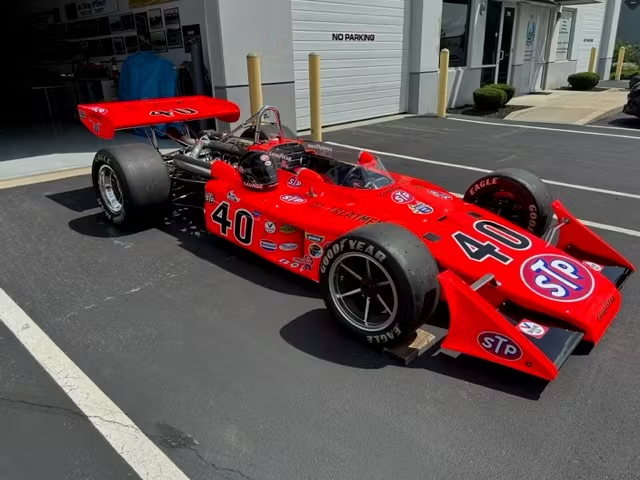
Now, enter Lashmett, Woerner, and Angela Savage—the baby Swede’s wife was pregnant with when he died, now all grown up.
“Soon after Swede’s death, I read that his wife was at the race, that she was pregnant, and that she witnessed his crash from the grandstand behind the pits,” said Woerner. “I just couldn’t imagine how a child could enter the world under such circumstances.”
Woerner never forgot her. Forty years later, in 2013, he heard that a trip was being organized to bring Angela Savage to the Indy 500. He met her and they became fast friends. That was the genesis for the book.
If it seems odd to restore a car to look exactly like the one Savage died in, well, it shouldn’t, Woerner said.
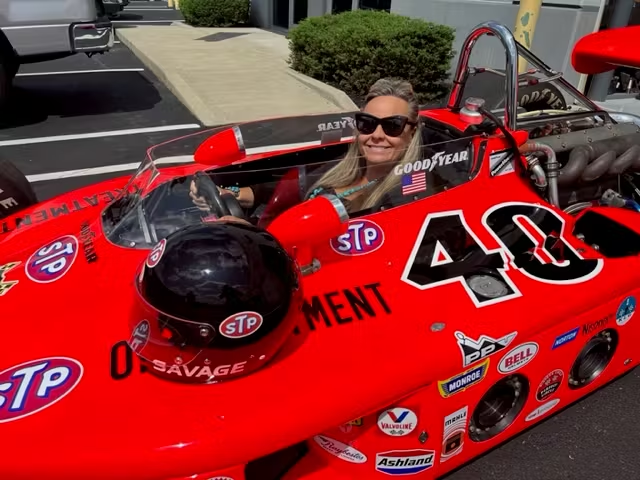
“It took Angela quite a while to get comfortable with the idea of this project before she granted us permission to move forward. We told her that the car would be seen as a celebration of his life, not his death. Once the car was completed, we revealed it to her in a private setting to help get her head around it all.”
“Angela sees it now as putting all the pieces back together again, and at the end of the day, she figured it was what her father would have wanted … I think he would have wanted to be represented in the Vintage Indy paddock with this car.”
Had Savage lived, he would have thrived in the racing world. “I think he could have been a superstar. He was just so charismatic, and handsome, popular with the ladies – he just had the California good looks right in the mold of Dan Gurney, his mentor. He was cool without trying to be cool,” Woerner said. “His ability, combined with his charisma – yeah, he would have been a very popular, and probably very wealthy, sportsman today.”
***
Check out the Hagerty Media homepage so you don’t miss a single story, or better yet, bookmark it. To get our best stories delivered right to your inbox, subscribe to our newsletters.
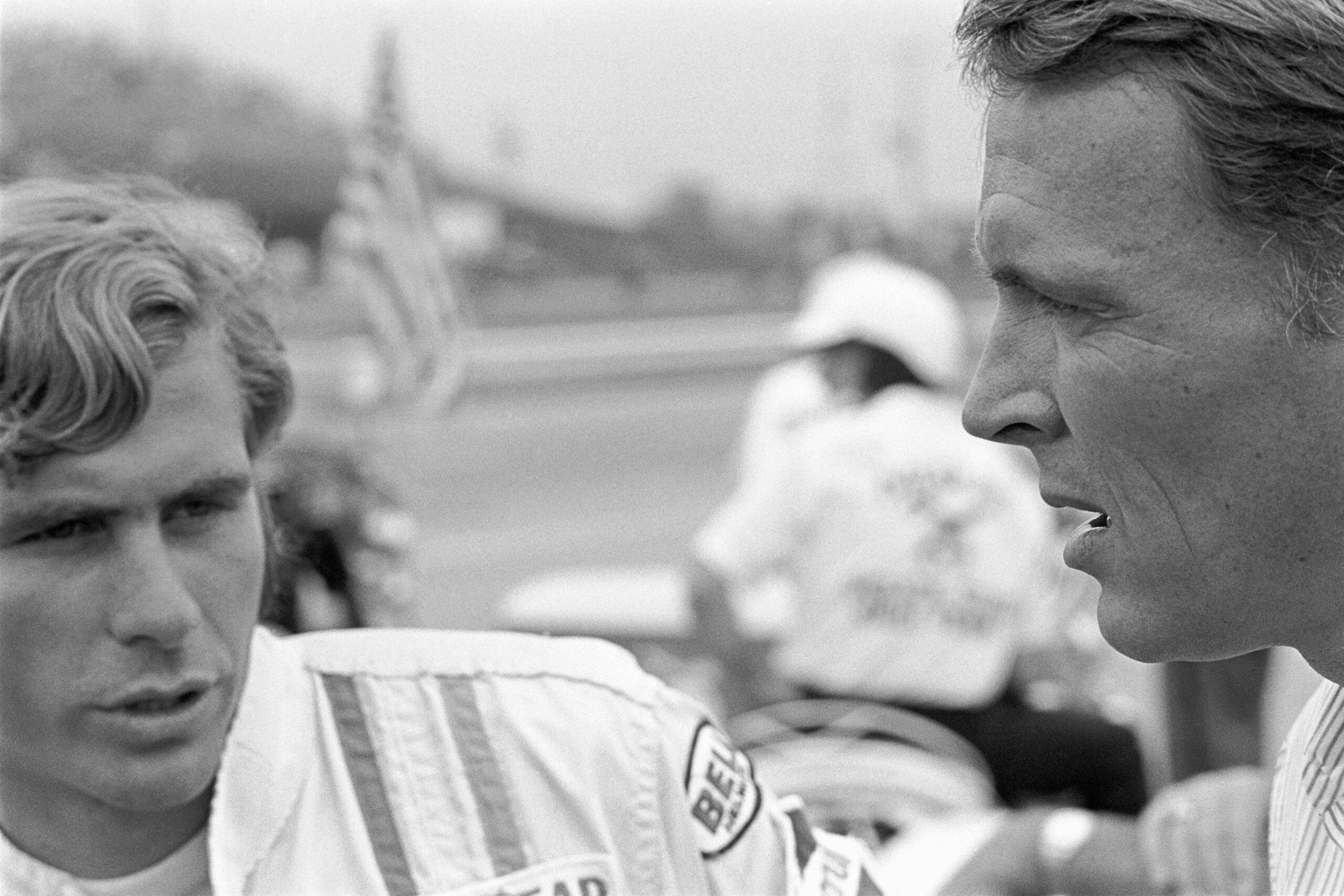
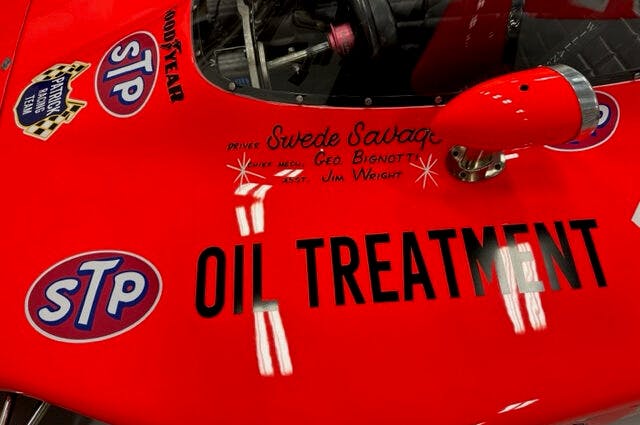


I well remember that race, one of the most horrible days in Indy500 history (and there have been more than a few). But the car? I agree – “it’s spectacular”.
I was ten years old and still remember all of this.
Savage could have gone far as a driver and I think Dan was going to play a big role in it.
He watched over him much.
I still have on display the #40 car and the 48/Cuda 1/18 diecast in my display cabinet.
I was old enough back then to see a number of driver die. I thank God it is rare today but Swede, Senna and Dale Sr all are etched in my memories having seen the go much too soon.
I have a resin model of Swede’s car I made. I those his livery as to honor him. The replica is beautiful.
Beautiful car. Such a tragic story. I did not know this story as this race happened before I was born.
I also remember it well. Even though I had long been a big Indy 500 fan by that time, it seemed like a dark cloud hung over that race, both literally and figuratively — culminating in that terrible crash. I still don’t like to think about that crash.
Beautiful car, a great tribute to a rising star we never got to see shine. I had lunch with his teammate Gordon Johncock after his retirement in ’85, a special day for me. He was still nursing the broken ankle from the previous season. He offered to sell me the watch he was given for the ’73 race. as he was dealing with a contentious divorce. I was surprised, as it was specially made and engraved for the race winner, but he reminded me of the race circumstances and he said he never felt like celebrating or remembering that victory. Those 1000 HP cars with 70 gal of explosive fuel were death traps, the drivers were heroes.
So….did you buy the watch? Maybe a morbid question, I know, but you introduced the subject, and now I wanna know! (and I bet I’m not alone)
Sadly, no. I tried to figure a way, but as a working stiff sales guy, at the time, it was out of reach. Gordon was living on his AZ ranch and was a friend of a friend (the one who invited me to lunch). I have to admit I was more than star stuck and really enjoyed the opportunity, even though I could not afford the watch. For the record, I don’t even remember the make (TAG, Rolex or Omega?), but it was enormous on my wrist (I didn’t drive terrifying race cars for a living) and had a beautiful custom dial and engraved back. As Gordon was selling it, I’m sure it’s in somebody’s collection. Note to my previous employer, I put the lunch on my expense account!
Raced motorcycles with Swede in the 60’s in So Cal was a fan of the ladies for sure, would be a driver to consider in the future lost way to soon, beautiful car to be remembered him by, thanks for story👍
It was my third Indy 500 as a teenager. We camped on Georgetown Rd and made multiple trips back and forth between our camper and the track every day due to the miserable weather. Swede was one of my favorite drivers and was hoping for him to do well. Each day they attempted to run the race there were more vacant seats. On Wednesday another fan offered us their tickets which were coincidentally on the front stretch near pit entrance. Things were looking good that day for Swede up until his accident. Needless to say his accident was devastating to witness. 1973 was definitely a tragic year for the 500 and one I’ll never forget.
I saw Swede pass in front of me three times in 1973. It was on the parade lap and the pace lap and under the yellow/red when the race was shutting down after the first lap accident. Had to come home and missed the resumption.